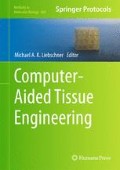Abstract
Rapid prototyping technologies were recently introduced in the medical field, being particularly viable to produce porous scaffolds for tissue engineering. These scaffolds should be biocompatible, biodegradable, with appropriate porosity, pore structure, and pore distribution, on top of presenting both surface and structural compatibility. Surface compatibility means a chemical, biological, and physical suitability with the host tissue. Structural compatibility corresponds to an optimal adaptation to the mechanical behaviour of the host tissue. This chapter presents a computer tool to support the design of scaffolds to be produced by rapid prototyping technologies. The software enables to evaluate scaffold mechanical properties as a function of porosity and pore topology and distribution, for a wide rage of materials, suitable for both hard and soft tissue engineering.
Access this chapter
Tax calculation will be finalised at checkout
Purchases are for personal use only
References
Almeida HA, Bártolo PJ, Ferreira J (2007) Design of scaffolds assisted by computer. In: Brebbia CA (ed) Modelling in medicine and biology VII. Wit, Southampton, pp 157–166
Almeida HA, Bártolo PJ, Ferreira J (2007) Mechanical behaviour and vascularisation analysis of tissue engineering scaffolds. In: Bártolo PJ et al (eds) Virtual and rapid manufacturing. Taylor & Francis, London, pp 73–80
Almeida HA, Bártolo PJ (2010) Virtual topological optimization of scaffolds for rapid prototyping. Int J Med Eng Phys 32(7):775–782
Almeida HA, Bártolo PJ (2007) Topological optimization of rapid prototyping scaffolds, International conference on manufacturing automation (ICMA2007), National University of Singapore, Singapore.
Almeida HA, Bártolo PJ (2008) Computer simulation and optimisation of tissue engineering scaffolds: mechanical and vascular behaviour. In: Halevi Y, Fischer A (eds) Proceedings of the ninth biennial ASME conference on engineering systems design and analysis (ESDA2008). Haifa Isreal
Bártolo PJ, Almeida H, Laoui T (2009) Rapid prototyping & manufacturing for tissue engineering scaffolds. Int J Comp Appl Technol 36(1):1–9
Chua CK, Yeong WY, Leong KF (2005) Development of scaffolds for tissue engineering using a 3D inkjet model maker. In: Bártolo PJ et al. (eds) Virtual modelling and rapid manufacturing. Taylor & Francis, London
Hutmacher DW, Sittinger M, Risbud MV (2004) Scaffold-based tissue engineering: rationale for computer-aided design and solid free-form fabrication systems. Trends Biotechnol 22:354–362
Almeida HA, Bártolo PJ, Mendes A (2009) Mechanical evaluation of alginate scaffolds considering the water loss/shrinkage process. In: Bártolo PJ et al. (eds) ICTE 2009 international conference on tissue engineering an ECCOMAS thematic conference. IST Press, Lisbon, pp 317–323
Andersson S (1983) On the description of complex inorganic crystal structures. Angew Chem Int Ed 22(2):69–81
Scriven LE (1976) Equilibrium bicontinuous structure. Nature 263(5573):123–125
Larsson M, Terasaki O, Larsson K (2003) A solid state transition in the tetragonal lipid bilayer structure at the lung alveolar surface. Solid State Sci 5(1):109–114
Lord EA, Mackay AL (2003) Periodic minimal surfaces of cubic symmetry. Curr Sci 85(3):346–362
Wang Y (2007) Periodic surface modeling for computer aided nano design. Comp-Aided Des 39:179–189
Humphrey JD, Delange SL (2003) An introduction to biomechanics – solids and fluids, analysis and design. Springer, New York
Fung YC (1990) Biomechanics: motion, flow, stress and growth. Springer-Verlag, New York
Neches L, Cisilino A (2008) Topology optimization of 2D elastic structures using boundary elements. Eng Anal Bound Elem 32:533–544
Ansola R, Veguería E, Canales J, Tárrago J (2007) A simple evolutionary topology optimization procedure for compliant mechanism design. Finite Elem Anal Des 44:53–62
Kruijf N, Zhou S, Li Q, Mai YW (2007) Topological design of structures and composite materials with multiobjectives. Solids Struct 44:7092–7109
Hsu MH, Hsu YL (2005) Generalization of two and three-dimensional structural topology optimization. Eng Optimizat 37:83–102
Bendsøe MP, Sigmund O (2003) Topology optimization: theory, methods and applications. Springer, Berlin
Rozvany GIN (2001) Aim, scope, methods, history and unified terminology of computer-aided topology optimization in structural mechanics. Struct Multidiscipl Optimizat 21:90–108
Bendsoe MP (1989) Optimal shape design as a material distribution problem. Struct Multidiscipl Optimizat 1:193–202
Bendsoe MP, Kikuchi N (1988) Generating optimal topologies in structural design using homosenization method. Comp Methods Appl Mech Eng 71:197–244
Mlejnek HP, Schirrmacher R (1993) An engineering approach to optimal material distribution and shape finding. Comput Methods Appl Mech Eng 106:1–26
Mlejnek HP (1992) Some aspects of the genesis of structures. Struct Multidiscipl Optimizat 5:64–69
Vogel F (1997) Topology optimisation of linear-elastic structures with ANSYS 5.4. NAFEMS conference on topology optimisation. Aalen, Germany
Acknowledgements
This research is supported by the Portuguese Foundation of Science and Technology through a Ph.D. grant of Henrique Almeida (SFRH/BD/37604/2007). The authors also wish to thank the sponsorship given by CYTED through a Biomanufacturing Network “Rede Iberoamericana de Biofabricação.”
Author information
Authors and Affiliations
Corresponding author
Editor information
Editors and Affiliations
Rights and permissions
Copyright information
© 2012 Springer Science+Business Media, LLC
About this protocol
Cite this protocol
Almeida, H.A., Bártolo, P.J. (2012). Structural and Vascular Analysis of Tissue Engineering Scaffolds, Part 2: Topology Optimisation. In: Liebschner, M. (eds) Computer-Aided Tissue Engineering. Methods in Molecular Biology, vol 868. Humana Press, Totowa, NJ. https://doi.org/10.1007/978-1-61779-764-4_13
Download citation
DOI: https://doi.org/10.1007/978-1-61779-764-4_13
Published:
Publisher Name: Humana Press, Totowa, NJ
Print ISBN: 978-1-61779-763-7
Online ISBN: 978-1-61779-764-4
eBook Packages: Springer Protocols

